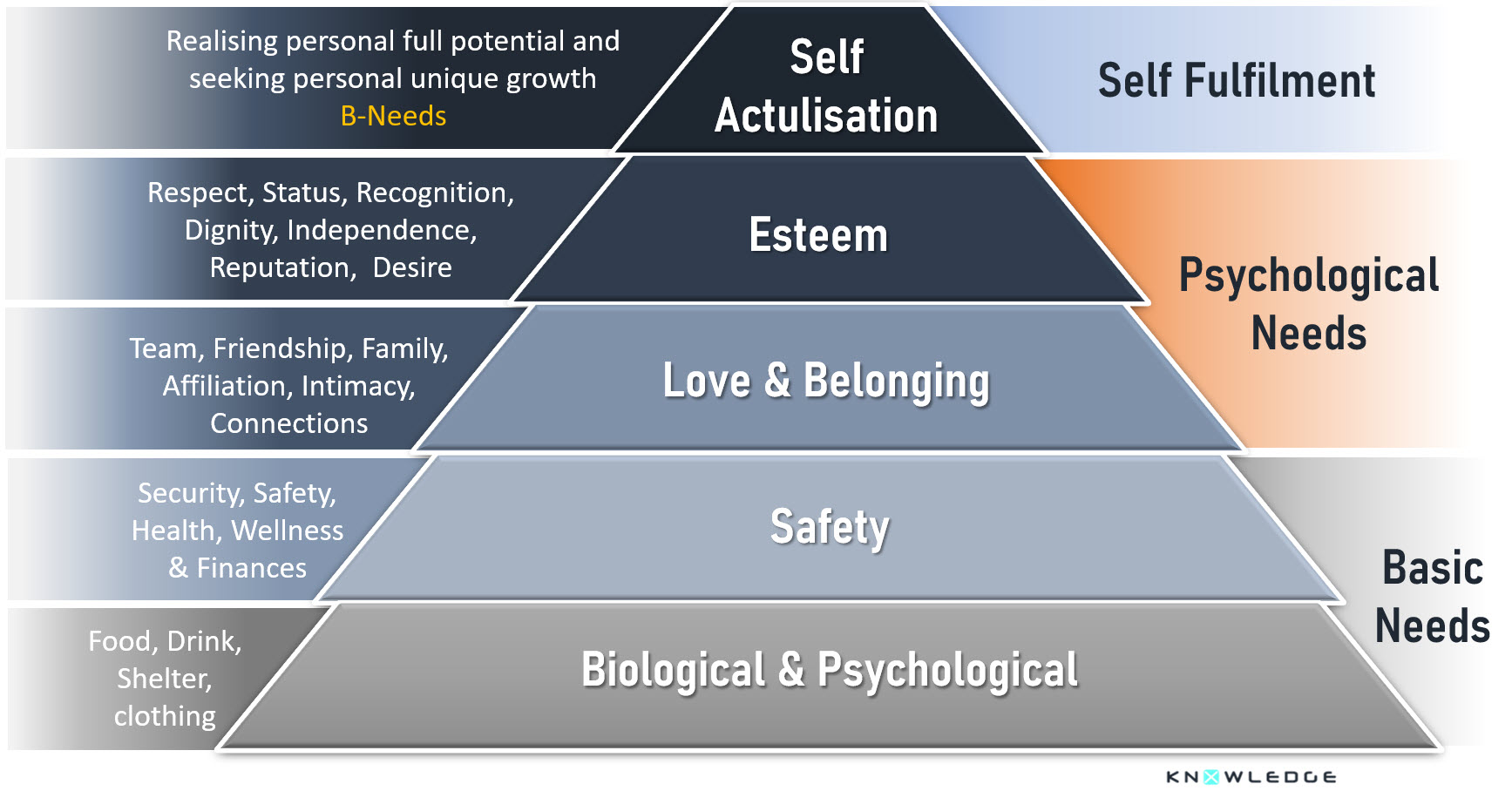Theory Background
Maslow’s hierarchy of needs is a motivational theory in psychology first proposed by Abraham Maslow, an American psychologist in 1943 in his paper “A Theory of Human Motivation” best known as Self-Actualisation Theory. The Maslow’s theory compromising a five-tier model of human needs in priority, often displayed as a hierarchical level within a pyramid. Maslow emphasised on the importance of focusing on the positive qualities in people.
A general psychology survey, published in 2002, ranked the Maslow hierarchy model as the 10th most cited in the 20th century.
Maslow’s hierarchy of needs theory
Abraham Maslow used the terms “physiological”, “Safety”, “Love & Belonging”, “Social Needs” or “self Esteem”, and “Self-Actualisation” to demonstrate the pattern through which human motivations hierarchy evolves. The lowest levels of the hierarchical pyramid consist of the most basic needs, while the top of the pyramid presents the most complex needs. Accordingly, it is a building bricks, the lower down needs must be satisfied first before individual can attend to needs higher up.

Deficiency Needs and Growth Needs
Maslow divided the five-stage model into both “Deficiency Needs” and “Growth Needs”. The first four levels are often referred to as Deficiency Needs (D-Needs), which arise due to deprivation.
The top level is known as the Growth or Being Needs (B-Needs). These needs don’t stem from lack of something, but rather from a desire to grow as an individual.
The motivation to fulfil the “Deficiency Needs” will become stronger the longer the duration they are unmet or denied and Oppositely, the motivation decrease as the needs are met. For example; the longer the person goes without rest, the more needy they will become to rest.
When it comes to the “Growth Needs”, motivation increases as needs are met and felt and may even become stronger once they are engaged. Growth needs don’t stem from the lack of something, but rather from the desire to grow as an individual.
Despite Maslow’s model refer that the lower down in hierarchy must be satisfied first before individual can attend to needs higher up. Unfortunately, this progress can be disrupted by failures in the lower levels needs. loss of job and divorce, may cause an individual to fluctuate between the levels of hierarchy back and forth.
The Maslow’s hierarchy five-tier model
Let look into the depicted five-tier hierarchical level within the pyramid
Physiological Needs
Those are the biological universal human needs for survival which is fairly apparent. e.g. food, drink, air, shelter, clothing, warmth and sleep. If those needs are not satisfied, the human body will not function to the optimum level. Hence, Maslow considered the physiological needs as the most important among all other needs and all other needs will be considered till these needs are met. Humans are compelled to fulfil these physiological needs first in order to pursue intrinsic satisfaction.
Safety Needs
Those are the safety elements that humans look for when the primary “physiological” needs are met. The needs now become a bit more complex. At this level, the need for safety and security become primary. Individuals at this level want control and order in their lives. In addition to the safety and security, individuals look for; order, law, financial security, health and wellness.
Together, the physiological and safety needs of the Maslow hierarchy model present what is referred to as the human basic needs.
Love and Belonging Needs
This is the third level of human needs. it involves the feelings of belonginess, and interpersonal relationships. e.g., belonging, friendship, intimacy, trust, acceptance, affection and love. It also includes the sense of affiliation; being part of a group (family, friends, team). Love and Belonging needs fulfilment results in lowering the feeling of loneliness, depression and anxiety.
Esteem Needs
At this point, it becomes increasingly important to gain the sense of respect and appreciation. Esteem needs starts to play a more prominent role in motivating behaviour.
Maslow classified this into two categories:
- Esteem for oneself (example; dignity, accomplishment, achievement, mastery, independence).
- Desire for reputation (example; respect from others, status, prestige).
Individuals capable of satisfying the esteem needs by achieving the self-esteem and recognition from others tend to feel they are making contribution to the world.
Self-Actualisation Needs
This is the level of realising personal full potential, self-fulfilment and seeking personal growth. Also known as the Growth or Being Needs (B-Needs). These needs don’t stem from lack of something, but rather from a desire to grow as an individual. As quoted by Maslow “A desire to become everything one is capable of becoming”. It is described by Maslow as the full utilisation and exploitation of talents, capabilities, potentialities, etc.
Theory Refining
Maslow refined the theory over several decades (Maslow, 1943, 1962, 1987). He Highlighted that the order in the structure of hierarchy “is not nearly as rigid” as he may have implied in his earlier illustrations of the theory, and that the order of needs might become vary and change based on the external circumstances or individual differences. For example; for come individuals the need to self-esteem may supersede the need for love.
Theory criticisms
- Wahba and Bridwell reported that there was little evidence for Maslow’s ranking of these needs and even less evidence of this hierarchical order.
- The theory is difficult to scientifically test speciality at the level of the self-actualisation.

Comments
No Comments added, be the first...